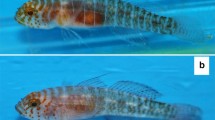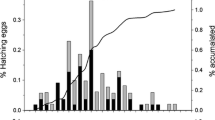Abstract
The reproductive behavior of male gray seals (Halichoerus grypus) breeding on land-fast ice at Amet Island, Nova Scotia, was studied. Data on energy expenditure (rate of mass loss over time) were collected. The average time budget of males at Amet Island was comparable to that of land-breeding males. The behavior of males showed seasonal changes, with a decrease in the proportion of time spent in the water and an increase in agonistic behavior during the peak mating period. The estimated amount of body mass lost over the season ranged between 25.6 and 77.1 kg, and the estimated percent of initial body mass lost ranged between 7.7 and 26.5% (n=10). The maximum number of observed copulations for an individual male was nine. Only 15 out of 42 males observed during 1992 and 1993 were seen copulating. The number of observed copulations per male was strongly correlated with success in remaining close to, or attending, females (r=0.91, P<0.001, n=42). The mean duration of attendance was 4.5 ± 5.54 days (n=42). Large size was not an important factor in determining attendance success, but reproductive effort (the estimated proportion of body mass lost over the season) and success in agonistic interactions with other males were both correlated with male success.
Similar content being viewed by others
References
Altmann J (1974) Observational study of behavior: sampling methods. Behaviour 49:227–267
Anderson SS, Fedak MA (1985) Grey seal males: energetic and behavioural links between size and sexual success. Anim Behav 33:829–838
Anderson SS, Harwood J (1985) Time budgets and topography: how energy reserves and terrain determine the breeding behaviour of grey seals. Anim Behav 33:1343–1348
Anderson SS, Burton RW, Summers CF (1975) Behaviour of grey seals (Halichoerus grypus) during a breeding season at North Rona. J Zool Lond 177:179–195
Arbuckle JL (1992) Amos 3.1. Department of Psychology, Temple University, Philadelphia
Bartholomew GA (1970) A model for the evolution of pinniped polygyny. Evolution 24:546–559
Boness DJ (1984) Activity budget of male grey seals, Halichoerus grypus. J Mammal 65:291–297
Boness DJ, James H (1979) Reproductive behaviour of the grey seal (Halichoerus grypus) on Sable Island, Nova Scotia. J Zool Lond 188:477–500
Cameron AW (1967) Breeding behaviour in a colony of Western Atlantic grey seals. Can J Zool 45:161–173
Castellini MA, Rea LD (1992) The biochemistry of natural fasting at its limits. Experientia 48:575–582
Clutton-Brock TH, Albon SD, Gibson RM, Guinness FE (1979) The logical stag: adaptive aspects of fighting in red deer (Cervus elaphus L.). Anim Behav 27:211–225
Clutton-Brock TH, Albon SD, Guinness FE (1988) Reproductive success in male and female red deer. In: Clutton-Brock TH (ed) Reproductive success. University of Chicago Press, Chicago, pp 325–343
Cohen J (1988) Statistical power analysis for the behavioral sciences, 2nd edn. L. Erlbaum, Hillsdale
Coulson JC, Hickling G (1964) The breeding biology of the grey seal, Halichoerus grypus (Fab.), on the Farne Islands, Northumberland. J Anim Ecol 33:485–512
Crowder MJ, Hand DJ (1990) Analysis of repeated measures. Chapman and Hall, London
Davies JL (1957) The geography of the gray seal. J Mammal 38:297–310
Deutsch CJ, Haley MP, Le Boeuf BJ (1989) Dominance rank and reproductive effort in male northern elephant seals. Am Zool 29:68A
Deutsch CJ, Haley MP, Le Boeuf BJ (1990) Reproductive effort of male northern elephant seals: estimates from mass loss. Can J Zool 68:2580–2593
Emlen ST, Oring LW (1977) Ecology, sexual selection, and the evolution of mating systems. Science 197:215–223
Farr L, Andrews RV (1978) Rank-associated differences in metabolic rates and locomotor activity of dominant and subordinate Peromyscus maniculatus. Comp Biochem Physiol A 61:401–406
Fedak MA, Anderson SS (1987) Estimating the energy requirements of seals from weight changes. In: Huntley AC, Costa DP, Worthy GAJ, Castellini MA (eds) Approaches to marine mammal energetics. Allen, Kansas, pp 205–226
Gadgil M, Bossert WH (1970) Life historical consequences of natural selection. Am Nat 104:1–24
Gibson RM, Guinness FE (1980) Behavioural factors affecting male reproductive success in red deer (Cervus elaphus). Anim Behav 28:1163–1174
Godsell J (1991) The relative influence of age and weight on the reproductive behaviour of male grey seals, Halichoerus grypus. J Zool Lond 224:537–551
Haller, MA (1994) The influence of timing of parturition on maternal behaviour and energetic investment by land-fast ice breeding grey seals (Halichoerus grypus). Masters thesis, University of Waterloo, Waterloo, Ontario
Hewer HR (1960) Behaviour of the grey seal (Halichoerus grypus Fab.) in the breeding season. Mammalia 24:400–421
Hirshfield MF, Tinkle DW (1975) Natural selection and the evolution of reproductive effort. Proc Natl Acad Sci USA 72:2227–2231
Hook O, Johnels AG (1972) The breeding and distribution of the grey seal (Halichoerus grypus, Fab.) in the Baltic Sea, with observations on other seals of the area. Proc R Soc Lond B 182:37–58
Kleiber M (1975) The fire of life: an introduction to animal energetics. Robert E Kreiger, Huntington
Kovacs KM (1987a) Maternal behaviour and early behavioural ontogeny of harp seals, Phoca groenlandica. Anim Behav 35:844–855
Kovacs KM (1987b) Maternal behaviour and early behavioural ontogeny of grey seals (Halichoerus grypus) on the Isle of May, UK. J Zool Lond 213:697–715
Krebs CJ (1989) Ecological methodology. Harper and Row, New York
Le Boeuf BJ (1974) Male-male competition and reproductive success in elephant seals. Am Zool 14:163–176
Le Boeuf BJ, Reiter J (1988) Lifetime reproductive success in northern elephant seals. In: Clutton-Brock TH (ed) Reproductive success. University of Chicago Press, Chicago, pp 344–362
Lindstedt SL, Boyce MS (1985) Seasonality, fasting endurance, and body size in mammals. Am Nat 125:873–878
Lott DF (1984) Intraspecific variation in the social systems of wild vertebrates. Behaviour 88:266–325
Mansfield AW, Beck B (1977) The grey seal in eastern Canada. Tech Rep Fish Mar Serv Canada 704:1–81
McCann TS (1981) Aggression and sexual activity of male southern elephant seals, Mirounga leonina. J Zool Lond 195:295–310
Siniff DB, DeMaster DP, Hofman RJ (1977) An analysis of the dynamics of a Weddell seal population. Ecol Monogr 47:319–335
Sokal RR, Rohlf FJ (1981) Biometry. WH Freeman, New York
Stirling I (1969) Ecology of the Weddell seal in McMurdo Sound, Antarctica. Ecology 50:573–586
Stirling I (1975) Factors affecting the evolution of social behaviour in the pinnipedia. Rapp P-v Reun Cons Int Explor Mer 169: 205–212
Stirling I (1983) The evolution of mating systems in pinnipeds. In: Eisenberg JF, Kleiman DG (eds) Recent advances in the study of mammalian behavior. American Society of Mammalogists, Washington, pp 489–527
SYSTAT (1992) SYSTAT for Windows: statistics, version 5 edn. SYSTAT, Evanston
Trivers RL (1972) Parental investment and sexual selection. In: Campbell B (ed) Sexual selection and the descent of man. Aldine, Chicago, pp 136–179
Author information
Authors and Affiliations
Rights and permissions
About this article
Cite this article
Tinker, M.T., Kovacs, K.M. & Hammill, M.O. The reproductive behavior and energetics of male gray seals (Halichoerus grypus) breeding on a land-fast ice substrate. Behav Ecol Sociobiol 36, 159–170 (1995). https://doi.org/10.1007/BF00177792
Received:
Accepted:
Issue Date:
DOI: https://doi.org/10.1007/BF00177792




